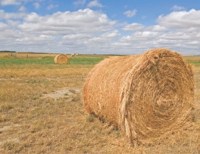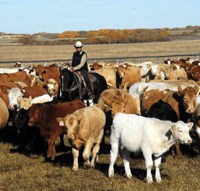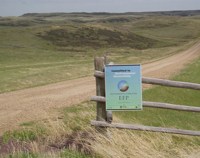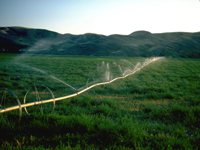Agriculture
A Critical Sector
Agriculture is a significant economic, landscape and cultural feature of Saskatchewan. The scale and diversity of agriculture in the province is important for food security and it significantly impacts on rural and urban development. Agriculture in Saskatchewan is vulnerable to climate change, as it is sensitive to variable conditions. Most of the largest year-to-year differences in production of both crops and livestock are related to climate and weather including extreme weather events of drought, hail, thunderstorms and late or early frost.
Although current and future climate change is a source of stress, farmers are already used to adapting to changing market conditions, changing technology, and changing transportation options. They have also evolved many strategies to manage current climate risk. An enhanced understanding of climate change and its potential impacts will further support proactive and effective adaptation.
What You Should Know
The Future Climate:
- Saskatchewan's climate is expected to be:
- warmer
- drier
- more variable and
- experience more frequent and more intense extreme events (e.g. heavy precipitation or drought).
- Precipitation patterns will change -- likely wetter, earlier springs and drier summers
- Droughts will likely increase in intensity and frequency
- The growing season is expected to:
- be longer
- start earlier
- be warmer
- have an overall increase in accumulated heat units.
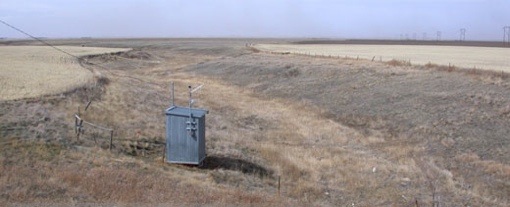
The Anticipated Impacts:
For Crops
- In the near term climate change provides:
- More options to grow different crop types. Pulse crops such as chickpeas and lentils adapt well to dry conditions.
- Yields may increase for some crops such as wheat and canola (plants using the C3 carbon fixation pathway).
- Weeds may be more vigorous.
- In the longer term:
- Yields will decrease on average with large losses in some years due to droughts or excessive moisture.
- There will be an increase in the productivity of arable land along the forest-grassland boundary.
- Warm season crops may become more viable, such as soybeans, corn and sorghum.
For Livestock
- Warming winters are generally favourable for livestock production, a result of improvements in feed efficiency and less stress from milder winters. Increasing threats of stresses related to summer heat, lack of water, insects and disease problems may offset gains.
- More frequent and longer heat waves could mean increased health problems for animals.
- Although a drier climate would suggest declining production and grazing capacity, actual changes in grassland production are likely to be modest, given a longer growing season, reduced competition from shrubs and trees, and increases in warm-season grasses that have higher water-use efficiency.
For Weeds, Insects and Pests
- Milder winters can increase the risk of insects, pests, diseases and weeds, including new pest species, and could mean greater challenges for managing crops and pasture.
For Water Availability
- More frequent and extreme droughts mean increased risk of water shortages for livestock and farms, and water stress for pastures and crops.
- Saskatchewan's mixed grassland ecoregion in the south and west is at risk of water stress
- Conflicts over increasingly scarce water supplies are one of the most serious risks for agriculture and society
For Economic Success
- Generally Canada's competitive trade position could improve, as Canada is expected to fare better than many other countries in terms of agricultural productivity. Net exports of cereal grains from North America are projected to increase.
Moving Forward - Adaptation Options:
Management & Planning
- Crops and grazing management planning should consider the following:
- Opportunities and risks arising from climate change
- Adaptive actions that support mitigation (sequestering carbon)
- Adopt beneficial farm management practices (BMPs) with adaptive components to climate change and drought. These may include:
- water well management,
- land management for soils at risk (e.g. the Permanent Cover Program has successfully reduced sensitivity to climate over a large area),
- cover crops,
- nutrient recovery from waste water,
- irrigation,
- grazing plans,
- integrated pest management,
- maintaining and restoring native prairie,
- improved direct seeding technology and systems,
- new crop rotations.
Irrigation
- Adopt new irrigation technologies and water management practices:
- Increased irrigation could compensate for increasing moisture deficits in Saskatchewan's southwest region, particularly as irrigation technologies and water management improve. For example, changing the timing of irrigation to after sunset and using more efficient irrigation methods can help offset increasing water demands.
- Increasing water recycling or issuing licenses to industries that are based on best water management practices and water recycling standards.
- Any new irrigation developments should take into account projections of future water availability.
- Increased irrigation could compensate for increasing moisture deficits in Saskatchewan's southwest region, particularly as irrigation technologies and water management improve. For example, changing the timing of irrigation to after sunset and using more efficient irrigation methods can help offset increasing water demands.
Research
- Investigate the potential to shift to higher value crops such as corn and soybeans in less water-deficient areas of the province.
- Investigate the potential and value of increasing the amount of acreage sown to winter crops. Winter crops, such as winter wheat, have a number of conservation advantages. These include improved control of soil erosion, more efficient crop moisture utilization, possibly reduced pesticide use, compatibility with zero tillage, and less disturbance to wildlife.
- Research - and extension and demonstration activities to put the results of research in the hands of producers - will be key contributors to successful agricultural adaptation to climate change.
Examples of Adaptation in Agriculture:
Pulse Crops
Pulse crops appear to be a useful adaptation to warming climates because of their drought and heat tolerance, efficient water use, and moisture-conserving growth habits. With warmer, longer growing seasons the area sown to pulse crops in the northern plains has accelerated in the last twenty years, especially in the semiarid regions where dry pea, chickpea, and lentils are used to extend the traditional wheat-fallow crop rotations.
Adaptation strategies include earlier seeding, use of winter pulses, crop sequencing in rotation and adjustments of microclimates (e.g. zero-till), and technologies that increase the water use efficiency of crops and cropping systems.
- Early spring seeding can improve dry pea productivity in the semiarid prairies.
- Management practices can enhance early seedling emergence, prolonged reproductive period, and increased pod fertility.
- Zero-till management and the resulting standing stubble are important for improving available water for crops by snow trapping, reducing wind speeds and evaporative demand for water and protection against soil erosion.
- Research indicates that further improvements to zero-till are possible, such as tall stubble systems and between-the-row-seeding systems.
Integrating Mitigation and Adaptation Activities
Agriculture in Saskatchewan is expected to play an important role in mitigating greenhouse gas emissions as well as adapting to a warmer, dryer climate. Appropriate integration of both adaptation and mitigation is needed to ensure that they are coordinated and mutually supportive.
Conservation tillage
Conservation tillage is an example of an agricultural management activity that integrates both mitigation and adaptation benefits:
- Reduced fuel consumption means less air pollution and CO2 production
- Buildup of soil organic matter enhances soil fertility and acts as a carbon sink
- Fertilizer is used more efficiently
- Improved infiltration of rain, snowmelt and reduced water runoff
- Less use of pesticides and fertilizer
- Less wind and soil erosion
Sources:
- Bauder, J. (1998): What are the water needs of pulse crops in arid region rotations?; Montana State University Communications Services.
- Climate Change Saskatchewan (no date): Agriculture in Saskatchewan: Dealing with a Changing Climate. [accessed March 16, 2010]
- Sauchyn, D. et al (2009): Saskatchewan's Natural Capital in a Changing Climate: An Assessment of Impacts and Adaptation. 162 pp.
- Weber, M. and Hauer, G. (2003): A Regional Analysis of Climate Change Impacts on Canadian Agriculture; Canadian Public Policy, v. 29, no. 3, p. 163-180.
